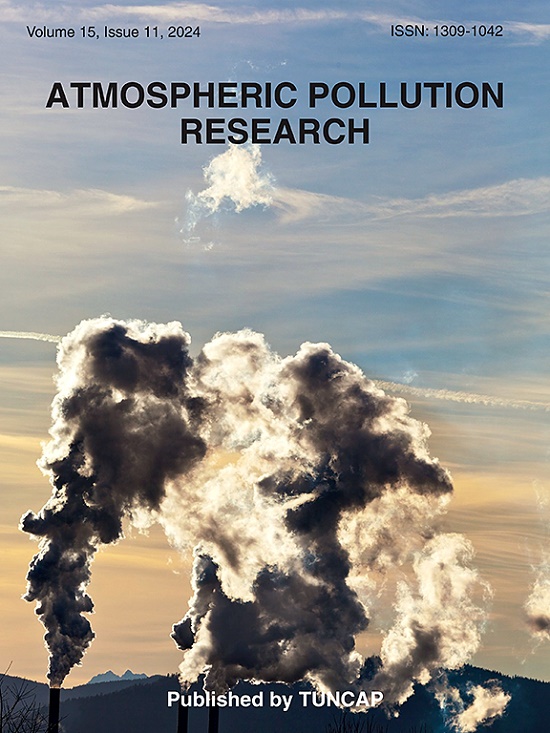Comprehensive analyses linking PM2.5 to its precursors and meteorological conditions across regions and time scale in China
IF 3.9
3区 环境科学与生态学
Q2 ENVIRONMENTAL SCIENCES
引用次数: 0
Abstract
This study conducts a comprehensive analysis of the intricate relationships between PM2.5 concentrations, their chemical precursors and meteorological factors across nine distinct regions in China from 2015 to 2022. Employing sophisticated wavelet-based methodologies—wavelet coherence (WTC), partial wavelet coherence (PWC), and multiple wavelet coherence (MWC)—the research delves into the scale-specific, temporal, and spatial interactions between these variables. Our findings reveal that CO and NO2 are the predominant precursors affecting PM2.5 concentrations across most regions, whereas SO2 holds greater influence in the South and Southwest. Key meteorological drivers include boundary layer height (BLH), wind speed (WU/WV), temperature (TM), precipitation (TP), and relative humidity (RHU), each exhibiting region- and time-scale-dependent impacts. Notably, BLH and wind speed play critical roles in PM2.5 dispersion in northern regions, whereas RHU and TP are particularly influential in the South and Southwest, especially during wet seasons. Temperature's influence is dual-faceted, showing positive correlations with PM2.5 on short time scales and negative correlations on longer scales. The study highlights the synergistic effects of meteorological factors and precursors, demonstrating that optimal combinations provide superior explanatory power for PM2.5 variability compared to individual factors. The East, South, and Southwest regions display the strongest coherence between PM2.5 and these combined influences, underscoring the need for region-specific and integrated air quality management strategies. These insights suggest targeted reduction of NO2 and CO emissions in the North and Northeast, and SO2 in the South and Southwest, while adapting to seasonal meteorological conditions, could significantly enhance PM2.5 mitigation efforts.

综合分析PM2.5与中国不同地区和时间尺度的前体和气象条件的关系
本研究对2015 - 2022年中国9个不同地区PM2.5浓度及其化学前体与气象因子之间的复杂关系进行了全面分析。采用复杂的基于小波的方法-小波相干性(WTC),部分小波相干性(PWC)和多小波相干性(MWC) -研究深入研究了这些变量之间的尺度特定,时间和空间相互作用。我们的研究结果表明,在大多数地区,CO和NO2是影响PM2.5浓度的主要前体,而SO2在南部和西南部的影响更大。关键的气象驱动因素包括边界层高度(BLH)、风速(WU/WV)、温度(TM)、降水(TP)和相对湿度(RHU),每一个都表现出区域和时间尺度相关的影响。值得注意的是,在北方地区,BLH和风速对PM2.5扩散起关键作用,而RHU和TP在南方和西南地区的影响尤为明显,特别是在雨季。温度对PM2.5的影响是双重的,在短时间尺度上与PM2.5呈正相关,在长时间尺度上与PM2.5呈负相关。该研究强调了气象因子和前兆的协同效应,表明与单个因子相比,最优组合对PM2.5变异的解释能力更强。东部、南部和西南地区在PM2.5与这些综合影响之间表现出最强的一致性,强调了针对特定区域的综合空气质量管理战略的必要性。这些见解表明,在适应季节性气象条件的同时,有针对性地减少北部和东北部的NO2和CO排放,以及南部和西南部的SO2排放,可以显著加强PM2.5的减缓工作。
本文章由计算机程序翻译,如有差异,请以英文原文为准。
求助全文
约1分钟内获得全文
求助全文
来源期刊

Atmospheric Pollution Research
ENVIRONMENTAL SCIENCES-
CiteScore
8.30
自引率
6.70%
发文量
256
审稿时长
36 days
期刊介绍:
Atmospheric Pollution Research (APR) is an international journal designed for the publication of articles on air pollution. Papers should present novel experimental results, theory and modeling of air pollution on local, regional, or global scales. Areas covered are research on inorganic, organic, and persistent organic air pollutants, air quality monitoring, air quality management, atmospheric dispersion and transport, air-surface (soil, water, and vegetation) exchange of pollutants, dry and wet deposition, indoor air quality, exposure assessment, health effects, satellite measurements, natural emissions, atmospheric chemistry, greenhouse gases, and effects on climate change.
 求助内容:
求助内容: 应助结果提醒方式:
应助结果提醒方式:


